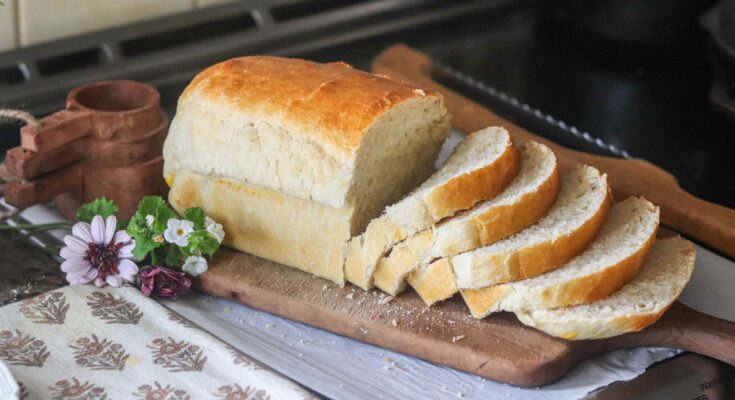Sourdough Sandwich Bread Recipe: Sourdough sandwich bread is a softer, milder version of traditional sourdough, making it perfect for sandwiches, toast, or just enjoying with butter. Unlike regular sandwich bread, this version is naturally leavened with wild yeast, which gives it a complex flavor and superior texture. If you’ve ever wanted to bake your own soft, tangy, and nutritious bread at home, this step-by-step guide will help you master the process.
Homemade sourdough bread offers several benefits:
- No artificial preservatives or additives.
- A healthier alternative due to natural fermentation.
- More digestible and gut-friendly compared to commercial bread.
Let’s dive into the details of making your perfect sourdough sandwich bread.
Ingredients Needed
To make a successful loaf of sourdough sandwich bread, you’ll need just a few basic ingredients.
Essential Ingredients:
- Active sourdough starter – ½ cup (fed and bubbly)
- Bread flour – 4 cups (for a chewier texture)
- Water – 1 ½ cups (filtered, room temperature)
- Salt – 2 tsp (enhances flavor)
- Honey or sugar – 2 tbsp (adds a slight sweetness)
- Butter or olive oil – 2 tbsp (for a softer texture)
Optional Ingredients for Enhanced Flavor:
- Milk – Replace some water for a richer taste.
- Egg – Adds structure and a softer crumb.
- Seeds or herbs – Flax, sunflower seeds, or rosemary for variety.
Tools and Equipment
Before we start baking, make sure you have the right tools.
Essential Baking Tools:
- Mixing bowls
- Kitchen scale (for accuracy)
- Dough scraper
- Stand mixer (optional but helpful)
- Proofing basket or loaf pan
- Sharp knife or lame (for scoring)
- Dutch oven or baking tray
If you don’t have a proofing basket, you can use a towel-lined bowl. No Dutch oven? A regular loaf pan works too!
Making the Sourdough Starter
Your sourdough starter is the key to fermentation. If you don’t already have one, here’s how to make it from scratch.
How to Make a Starter:
- Day 1: Mix ½ cup whole wheat flour and ¼ cup water in a jar. Cover loosely.
- Days 2-7: Feed it daily with ¼ cup flour and 2 tbsp water. Stir well.
- By Day 7: Your starter should be bubbly and have a slightly tangy smell.
Once your starter is active and doubles in size within 4-6 hours of feeding, it’s ready for baking.
Step 1: Mixing the Dough
Now that you have an active starter, let’s start making the dough.
Instructions:
- In a large bowl, mix 1 ½ cups water, ½ cup starter, and 2 tbsp honey.
- Add 4 cups bread flour and mix until combined.
- Let it rest (autolyze) for 30 minutes.
- Add 2 tsp salt and 2 tbsp butter, then knead for 8-10 minutes.
You can use the stretch-and-fold method instead of kneading: every 30 minutes, stretch the dough and fold it over itself. Repeat 3-4 times.
Step 2: Bulk Fermentation
Bulk fermentation is the most crucial step, where your dough develops structure and flavor.
How Long Should Bulk Fermentation Be?
- Room temperature (70-75°F): 4-6 hours.
- Cooler environment: 8-12 hours.
Signs That Bulk Fermentation is Complete:
- Dough has doubled in size.
- Air bubbles form under the surface.
- The dough feels airy and soft.
Step 3: Shaping the Dough
Once your dough is fully fermented, it’s time to shape it into a loaf.
How to Shape the Dough for Sandwich Bread:
- Lightly flour your surface and place the dough on it.
- Gently flatten it into a rectangle.
- Fold it like a letter, then roll it into a tight log.
- Place it into a greased loaf pan.
Make sure to shape it tightly to avoid gaps in the final loaf.
Step 4: Final Proofing
Your dough needs one last rise before baking.
How to Proof Properly:
- Cover the dough and let it proof at room temperature for 2-4 hours.
- Use the poke test: Press your finger into the dough—if it springs back slowly, it’s ready.
Step 5: Baking the Bread
Now comes the most rewarding part—baking your sourdough sandwich bread!
Baking Instructions:
- Preheat your oven to 375°F (190°C).
- Brush the top with melted butter for a golden crust.
- Bake for 35-40 minutes until golden brown.
- Let it cool before slicing.
Step 6: Cooling and Storing
After baking, allow the bread to cool completely on a wire rack. Store in a bread box or airtight container.
- Room temperature: 3-4 days.
- Freezer: Up to 3 months (slice before freezing for easy use).
Troubleshooting Common Issues
Even experienced bakers run into issues. Here’s how to fix common problems when making sourdough sandwich bread.
1. Bread is Too Dense or Gummy
- Cause: Underproofing or too much moisture.
- Solution: Ensure the dough has doubled during fermentation and use less water if your dough is too sticky.
2. Bread Didn’t Rise Properly
- Cause: Weak starter or improper proofing.
- Solution: Make sure your starter is active and bubbly before use. Give the dough enough time to rise at a warm temperature.
3. Overproofed vs. Underproofed Dough
- Overproofed dough: Feels too weak and collapses when touched. Bake immediately if overproofed.
- Underproofed dough: Feels tight and doesn’t expand much in the oven. Let it ferment longer before shaping.
Variations and Flavor Enhancements
Sourdough sandwich bread is great on its own, but adding extra ingredients can enhance its taste and texture.
1. Whole Wheat Sourdough Sandwich Bread
- Replace 1 cup of bread flour with whole wheat flour for a heartier loaf.
- You may need to add a little extra water since whole wheat absorbs more moisture.
2. Sweet Sourdough Sandwich Bread
- Add ¼ cup sugar and 1 tsp cinnamon for a mildly sweet version.
- This pairs well with butter and jam for breakfast.
3. Seeded Sourdough Bread
- Add 2 tbsp sunflower seeds, flaxseeds, or sesame seeds to the dough.
- Sprinkle extra seeds on top before baking for a crunchy crust.
Health Benefits of Sourdough Bread
Why is sourdough better than regular sandwich bread?
+ Easier Digestion – The natural fermentation breaks down gluten, making it easier on your stomach.
+ Rich in Nutrients – Higher levels of vitamins and minerals compared to store-bought bread.
+ Better Gut Health – Contains beneficial bacteria that support digestion.
Serving and Pairing Ideas
Wondering how to enjoy your homemade sourdough sandwich bread? Here are some ideas:
1. Classic Sandwiches
- Grilled cheese with sourdough takes the flavor to another level!
- Make a BLT or turkey sandwich for lunch.
2. Toasted Breakfast Options
- Top with avocado, eggs, or peanut butter for a hearty breakfast.
- Spread with butter and jam for a simple, delicious snack.
3. French Toast and Croutons
- Stale sourdough makes the best French toast or homemade croutons.
FAQs about Sourdough Sandwich Bread Recipe
1. Can I make this sourdough sandwich bread without a sourdough starter?
No, this recipe relies on a sourdough starter for fermentation and rise. If you don’t have one, you can make a starter from scratch or use commercial yeast for a different version.
2. How do I get a soft and fluffy texture?
For a softer crumb, ensure your dough is well-hydrated and properly kneaded. Adding a small amount of butter or milk can also enhance softness.
3. How long does sourdough sandwich bread last?
Stored at room temperature in an airtight container, it stays fresh for about 3-5 days. You can also freeze it for up to 3 months.
4. Why is my sourdough bread dense?
A dense loaf is often due to under-proofing. Make sure your dough has doubled in size during bulk fermentation before shaping and baking.
5. Can I make this recipe gluten-free?
Sourdough relies on gluten for structure, but you can try a gluten-free sourdough bread recipe using alternative flours like rice or buckwheat.
6. What’s the best way to store and reheat this bread?
Store at room temperature in a bread bag or wrapped in a towel. To reheat, lightly toast or warm in an oven at 350°F for 5-10 minutes.
7. Can I add flavors or mix-ins to my sourdough sandwich bread?
Absolutely! You can incorporate honey, herbs, cheese, or seeds for extra flavor without compromising the texture.
Final Thoughts
Making sourdough sandwich bread takes time and patience, but the reward is well worth it. The soft crumb, mild tang, and superior nutrition make it a perfect choice for daily bread. Whether you enjoy it as a sandwich, toast, or simply fresh out of the oven, homemade sourdough will always be better than store-bought.
Start baking today, and don’t be afraid to experiment with flavors and techniques!



